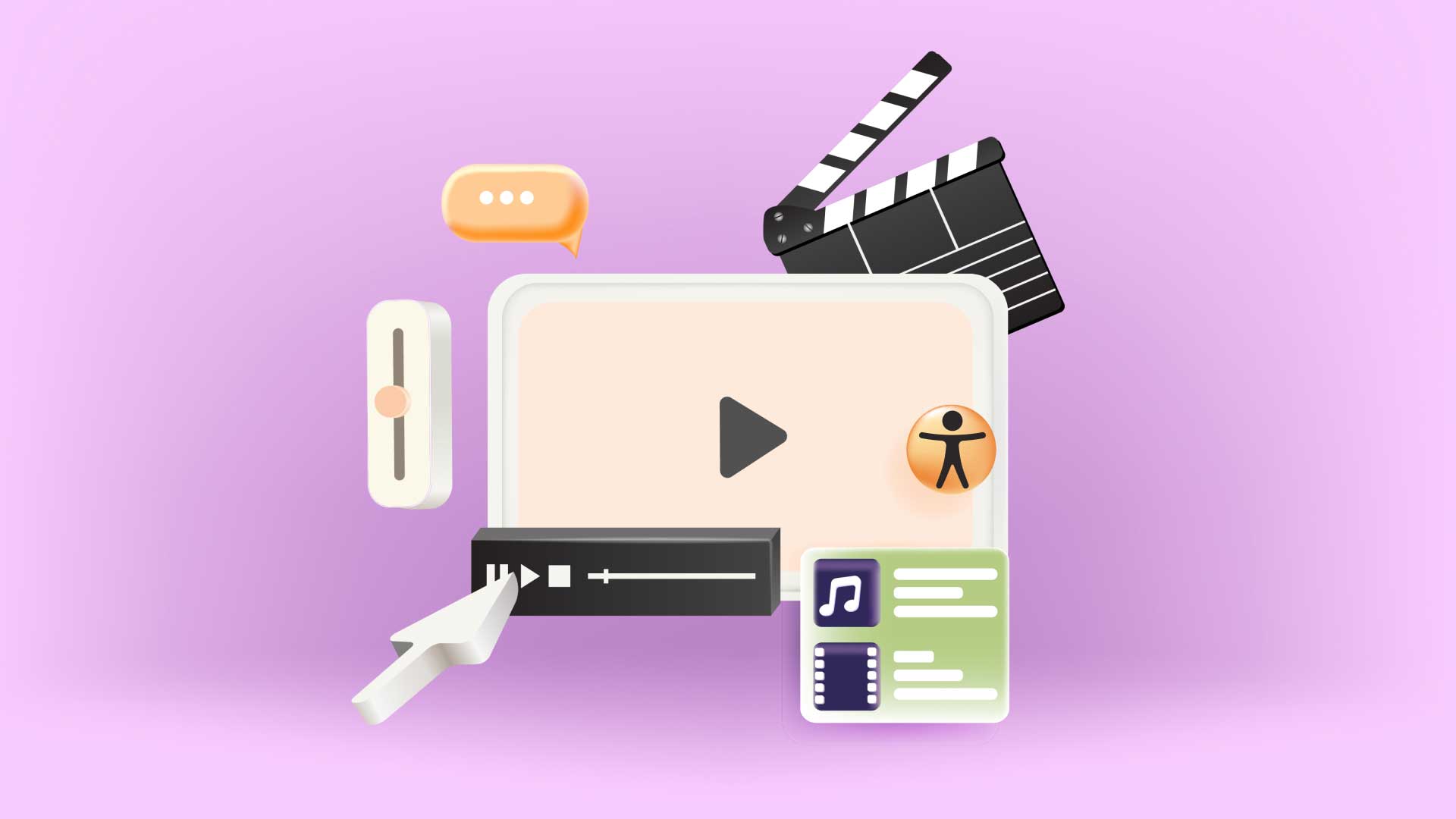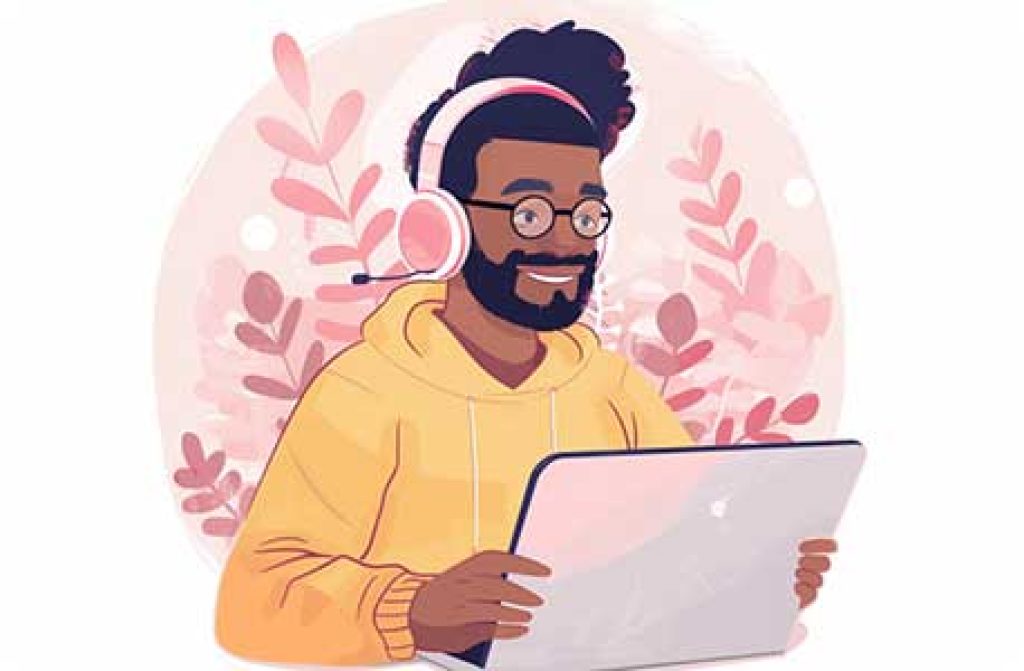
Making Videos Accessible: Must-Dos For Creators & Consumers
Online video has become a dominant form of communication and entertainment. From educational tutorials and news reports to entertainment vlogs and short-form content on social media platforms, videos offer a dynamic way to share and receive information, stories, and ideas. This versatile and sometimes volatile medium has become integral to how people learn, connect, and entertain themselves and each other. Video-sharing and streaming platforms like YouTube and TikTok supply a constant flow of popular content, from brief comedic clips to documentaries, accurate or otherwise. Users actively engage with this content, leaving comments, sharing videos with friends and frenemies, and subscribing to their favorite creators. Because it is so en vogue as a medium, and because viral videos instantly become social currency and commentary, people of all ages, especially teens and young adults, are leaning into video for more than a laugh or the latest hacks: they’re reaching for a sense of belonging within their peer groups.
With video’s rise to its current status as reigning heavyweight of the digital ring, the importance of making video content equally accessible to everyone has grown proportionally. No one can deny that video clips and reels traverse the virtual terrain like wildfire, and aside from their entertainment value, they have become an up-to-the-minute combination of breaking news and popular opinion report, elbowing aside even the bird currently known as X. Clearly, as with any news and communication channel, video media must be available to everyone. Disabilities shouldn’t stand in the way of anyone’s access to information and interaction. More to the point, we shouldn’t let that happen.

A Rewarding Remix: Video Content’s Compelling Benefits
Studies show that people retain information better when it comes from videos rather than text. 90% of all information transmitted to the human brain is visual data. And, processing in the brain happens 60,000 times faster for visuals than for text: image viewing, analysis, and recognition in context all happen within 100 milliseconds, and an MIT report estimates that our brains can recognize even images that are unfamiliar to us in 13 milliseconds. To give you a frame of reference, a blink of your eyelid can takes between 100 and 400 milliseconds. So yeah, 13. That’s fast.
Humans simply know how to interpret information better that way, it seems: reading began with picture symbols, and our brain still wants to think about letters and words as images that we recognize, before the idea of the text gets through to us. And, about 65% of the general population are visual learners, meaning that’s how they learn best: through visual data. So, videos are not only easier to absorb, they’re also less forgettable. That’s powerful.
Also amping up the emotional punch of video is the addition of sound, including background music. As goofy as some of the repetitive sound clips can be, they help create an immersive experience, making it multisensory. Music not only taps into our feelings, when used to create an emotional atmosphere in film and video, even cheesy soundtrack music has a very strong impact on not only a fleeting mood, but on how we respond to the video. Of course, a sad dog with puppy eyes staring at the camera is going to elicit an “aww”. But add in a melancholy tune and viewers will wipe away a tear. Is that bad? No, not really. Most of us enjoy having these brief emotions, especially in the context of digital entertainment. It’s vivid but also absolutely nonthreatening: it can touch our hearts, but it can’t really hurt us.

Around The Virtual Campfire: Video Storytelling
Besides for the fact that human brains love pictures, and they love moving pictures with music even more, what’s video got to offer the end user? Stripped down to its essence: video serves up storytelling, and that works really well for us. While not every video is literally telling a story, that’s the overall effect of how we connect to video information.
Our brains are wired for narrative. Storytelling activates a network of regions associated with language processing, emotion, memory, and social interaction. This engagement triggers the release of neurotransmitters like dopamine, which triggers reward reactions and reinforces attentiveness. Stories also stimulate empathy by inviting us to inhabit characters' experiences, letting us feel a sense of understanding and connection with others. The inherent appeal of storytelling makes it a powerful tool for learning and communication. Complex information can be packaged within a relatable narrative, enhancing retention and comprehension. Similarly, stories can explain abstract concepts in a way that resonates emotionally, making them easier to grasp and share. Ultimately, storytelling serves as a fundamental human tool for learning, explanation, and forging connections. Here’s how videos and the stories they tell help users:
- Clear Explanations of Complex Topics
With video visuals plus voiceover, even difficult information can be explained down to the last detail. - Engagement & Captured Interest
Because video is so dynamic, the experience pulls us in. Why is that important? Well, the video’s message may not be critical. But we dive in and get to engage with the information. That’s fun for our brains. - Flexible Access to Information
Videos offer on-demand learning and entertainment. Users can access content at their convenience, which is pretty much 24/7/365 unless the wifi is down. - Accessibility For Cognitive & Learning Differences
Videos can be a great alternative for people who struggle with reading large amounts of text. - Diverse Content
Streaming video platforms present users with a wide range of content, from educational to entertaining. There’s something for almost everyone’s interests, whether that’s funny skits, music, or baking competitions. - Social Interaction and Connectivity
Videos on social media platforms cultivate community, building on interaction between viewers, breaking down geographical barriers.

Web Accessibility and Video Content
Web accessibility refers to the design, development, creation and upkeep of websites and digital content in such a way that they can be easily used by everyone, including people with disabilities. This concept is vital for establishing and maintaining digital inclusivity. By removing barriers that prevent access to web-based services and content, web accessibility opens up digital access so that all users, regardless of their physical or cognitive abilities, can navigate, understand, and interact with the web.
Videos often lack accessibility features like captions and audio descriptions, creating a blocker for viewers with disabilities. Making videos accessible removes these constraints, securing equal access to information, education, entertainment and social interaction for everyone.
Legal Frameworks for Video Accessibility
The World Wide Web Consortium (W3C), an independent, international public interest organization, has created and developed the Web Content Accessibility Guidelines (WCAG) as part of its Web Accessibility Initiative (WAI).
The WCAG is not a law in any country. However, it is the basis of many laws. The WCAG serves as a widely recognized benchmark, outlining how to create web content usable by people with disabilities. Many countries reference the WCAG when establishing or updating their own accessibility laws.
In the United States, the Americans with Disabilities Act (ADA) sets forth requirements for digital, electronic, and communications accessibility. Although the ADA does not specifically mention the internet, legal precedents and Department of Justice settlements have interpreted its scope to include websites and online video content, making ADA compliance for videos a significant consideration for content creators and distributors. Similarly, Section 508 of the Rehabilitation Act (US) applies to United States federal government agencies, requiring their electronic and information technology, including websites and videos, to be accessible to people with disabilities. Because these laws have been construed to cover web and digital accessibility, many organizations and businesses that work with the government have implemented or begun to implement accessibility on their own websites, applications and internet or electronic content and documents. This approach works to safeguard the rights of people with disabilities, granting legal protection against disability-based discrimination, so that organizations feel compelled to deliver accessible web-based services and content. The end result is more and better accessibility for people with disabilities, including access to video media in digital environments.
Core Accessibility Features for Video Content
Core accessibility features for videos extend alternative ways for people with disabilities to access the auditory and visual content of a video.
What Is Alternative Access In Accessibility?
Adding alternative access to online content refers to the practice of making information available through various sensory modalities, to accommodate users with different sensory abilities or preferences. This is a means for users to access content in a way that bypasses the default sensory pathway, which might be visual or auditory.
Example
For instance, text or audio descriptions for visual content can be used to alternatively convey information to people with visual impairments, so they understand what the visual is saying even when they can’t see it themselves. Audio descriptions add a layer of inclusivity by narrating visual elements, providing information and context for people who are blind or have low vision.
Adding sign language interpretation or captions and subtitles to audio content presents individuals with hearing impairments with another (alternative) way to receive audio-based information, without needing full hearing abilities.
In this way, information is made perceivable and accessible to users regardless of their sensory capabilities.
Tools and Technologies: Adding Accessibility To Video Content
There are several tools, methods and technologies that can make videos more accessible. Let's explore how each one works to support video viewers with disabilities:
- Captioning and Subtitles
Text captions display the dialogue and sound effects of a video. This is essential for viewers who are deaf or hard of hearing. It also aids viewers who speak a different language from the video's audio. Popular platforms like YouTube and Vimeo offer built-in captioning features, and automatic captioning tools are becoming increasingly accurate. - Audio Descriptions
Audio descriptions provide narrated explanations of key visual elements in a video, such as scene changes, actions, and facial expressions. This is vital for viewers who are blind or have low vision. Recent releases with audio description include Netflix's increasing catalog of audio-described content, Apple TV+'s commitment to audio descriptions in multiple languages, and Disney Plus's expansion of audio-described content for its major releases. - Web Accessibility Overlays for Videos
Web Accessibility Widgets are software applications that add accessibility features to existing web and digital content, including online videos. These tools can include features like captions, transcripts, and keyboard navigation controls. Popular web accessibility overlay providers include accessiBe and Userway. While some overlays may not be compatible with every video platform, it’s worth trying the best-rated tools, because not every video will have another available and functional accessibility option. - Transcripts for Videos
A transcript is a written version of the dialogue and sound effects in a video, usually available for prerecorded content rather than live events. Transcripts are useful for viewers who are deaf or hard of hearing, viewers who speak a different language, and those who prefer to get their information through text. Many online courses and educational videos offer transcripts alongside their video content: for example, TED Talks furnish full subtitles as well as time-coded clickable transcripts for nearly all their presentations. Educational platforms like Coursera have transcripts for their video courses, on mobile as well as desktop app versions, although they do not have hyperlinks. And, major news websites sometimes include transcripts for video reports. Transcripts may also be searchable, which is an improvement over scrolling through the entire transcript text or even running an entire video clip to find a single piece of information.
Making Videos Accessible: Tips for Creators and Viewers
Video Creators
As a responsible content creator, you’ll already have thought of many of these, but here are some good reminders:
- Integrate Captions and Subtitles
Provide accurate captions for spoken dialogue and essential sound cues. Add captions during editing or use automatic captioning tools, followed by manual review for accuracy. - Include Transcripts
Offer a transcript alongside the video whenever possible. - Write & Speak Clearly
Speak clearly and intelligibly; avoid background noise. Consider writing up a script and practicing so that any important information is well-phrased and delivered slowly. - Incorporate Audio Descriptions
Briefly narrate key visual elements in the video as they appear, especially for presentations. - Accessible Editing Practices
When placing text on a video background during editing: Prioritize clear, legible fonts for any on-screen text. Check that you have a high enough contrast ratio between your text and background color. And, consider adding a layer of contrasting background color behind your on-screen text if it will move across busy or distracting elements on the screen. - Keep Accessibility In Mind
When setting up scenes, backgrounds, and any added text, use color combinations that will be visible to viewers with color blindness: don’t use red and green together, for example. Avoid relying solely on color to convey important information: you can’t assume everyone will see it.
Video Viewers
Think you can’t make videos more accessible after the fact? Think again. Viewers have accessibility options too.
- Turn On Captions & Subtitles
Most video platforms offer caption options. Turn them on to follow the dialogue and sound effects. - Adjust Audio Settings
Many platforms allow adjusting playback speed or audio settings. Experiment to find your best settings. - Customize Display Settings
Adjust your device display settings for higher contrast and larger text to improve visibility. - Apply Assistive Technologies
Utilize screen readers to navigate video platforms and read video transcripts. - Use Accessibility Tools
Explore browser extensions or accessibility overlays with features like enlarged text or altered color contrast.
Video Presentations
When creating and editing video presentations, especially those with lots of visual detail, it’s best to consider any visually impaired members of your audience.
- Enlarge Visuals and Text
While it may not be right for a casual TikTok, enlarging images and text can be very helpful in educational content and some work-related presentations, where detailed diagrams or long texts are often shown. Make sure viewers with low vision can easily perceive any relevant information you share. - Set Up Clear Contrast and Visibility
Achieved by using a simple, uncluttered background with a contrasting color for foreground elements, this step makes content easily distinguishable for viewers with vision impairments. - High Contrast Color Combinations
Opt for high-contrast color schemes for general visual content, especially for text, which will improve legibility for those with color vision deficiencies or low vision.
Keep Rolling: Lights, Camera, Accessibility Action
In today's digital world, creating accessible video content is another important step towards a more inclusive society. Videos are a powerful communication tool. But, without accessibility features, they can exclude viewers with disabilities. By following accessibility guidelines, video creators can help craft a virtual world where everyone has equal opportunities to learn, engage, be entertained, and find their social niche.
Videos offer a rich, immersive way to share knowledge, tell stories, and connect with others. Prioritizing video accessibility is an essential part of ushering us all into the best of the digital age, with no one left behind, regardless of ability. This surge of collective effort towards inclusivity not only elevates the user experience for individuals with disabilities, it strengthens and enriches our human society as a whole, moving us closer to a future where accessibility is a universal standard, and equality and justice can be relied upon. By working together to build, improve and maintain accessibility in our digital environments, we contribute our bit to positive societal advances, demonstrating the enduring worth of empathy in spite of the passage of time and the crumbling of so many old-fashioned values. Thoughtful inclusion and considering the different needs of our neighbors will never go out of fashion, whether or not TikTok stays on trend. Kindness sticks around. And, with a deep commitment to building a world where digital resources, including video content, are open and accessible to everyone, so will we.
FAQs
A video is ADA compliant when it fulfills all WCAG accessibility criteria. It should include features like captions, audio descriptions, and accessible media player controls, making it usable by individuals with various disabilities.








